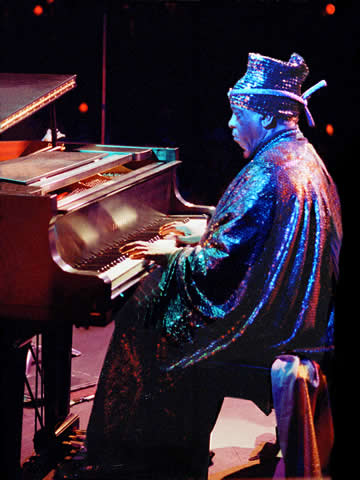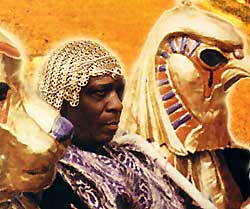SUN RA / “Lullaby For Realville”
Last week, we checked out two albums featuring some of Sun Ra’s accessible side—swinging standards and soothing originals, all of it fairly easy on both the ears and the mind. Kalamu called it square music for hipsters (or hip music for squares). I’d never call it that myself, but I know where Kalamu’s coming from. Some of Sun Ra’s later music has a pleasant, kitschy vibe that may appeal to folk who’d never otherwise listen to jazz.
This week, we’re featuring another Sun Ra album, and it sounds nothing like Blue Delight or Purple Night. Sun Song was originally released way back in 1957 as Jazz By Sun Ra. It is the earliest Sun Ra music I’ve heard and, depending on who’s counting, is either his first or second album. Given that it is one of the first recordings of a decades-long career, Sun Song has a surprisingly mature sound. Then again, by ’57 Sun Ra had been leading his own band off and on for nearly twenty years. So in a way, Sun Song is as much a culmination as it is a debut.

Sun Ra’s original compositions are buoyant and humorous but also communicate a lot of intelligence. It’s the type of jazz I listen to when I’m feeling energetic and optimistic. The tunes are traditional in overall sound: at first listen they’re a lot like other hard bop of the time…think Art Blakey or Clifford Brown. On the other hand, both the instrumentation and the arrangements are unusual. Sun Ra’s structures his tunes so that solos stop and start when you aren’t expecting it. Also notice the way he pits light sounds against heavy ones. For example, at the beginning of “Brainville,” the airy tone of a muted trumpet meets the dark blasts of a baritone sax. Another distinction of Sun Ra’s early sound is the unusual solo instrumentation. You’ll hear solos from not just common instruments like the tenor saxophone (lifelong Ra band member John Gilmore) and the piano (Sun Ra himself) but also from rarely-featured instruments like the tuba and the pocket trumpet.
Sun Ra wrote seven of the nine compositions from Sun Song, but my favorite tune, “Lullaby For Realville,” is actually by Richard Evans, the bass player for the session who’d go on to become one of the preeminent session musicians of the Chicago soul-jazz scene as well as the man behind The Soulful Strings. “Lullaby” has that deep-in-the-pocket groove that soul-jazz fans will recognize from their favorite records by The Three Sounds, Eddie Harris or Cannonball Adderley. I especially like the way Evans puts the break right up front—the song begins with nothing but a funky bassline and syncopated hand-claps.
Next week, Sun Ra one more ‘gain.
—Mtume ya Salaam
Celestial history of the music
Ra in retrograde. Although Sun Ra was known for his out/outer space (avant garde) sounds, Ra had a rootsy side in the history of Black music and also was heavily invested in the entertainment side of the presentation of the music (i.e. stage shows, revues, shake dancers, etc.). Plus, Ra was an infamous task master, keeping the band in rehearsals, going over and over material.
Anyway, here are three examples taken from early developments of jazz. “King Porter Stomp” is by Jelly Roll Morton, another “colorful” jazz character who often boasted that he invented jazz. While that claim seems dubious on the face of it, when one does the research for corroborating evidence, it does seem to be true that Jelly was the first to leave behind manuscripts of jazz compositions and arrangements.
“Big John’s Special” is by the renowned Fletcher Henderson, a bandleader and master arranger from the twenties and thirties. Trivia note: Fletcher’s arrangements were used by the Benny Goodman band.
“Take The A Train” is the well-known Duke Ellington band theme that was written by Billy Strayhorn, the wizard behind the curtain who was often called Duke’s alter ego. We’ve written about Billy before and undoubtedly we’ll touch on more of Strayhorn's music as the years go on.
Sun Ra was not only aware of his/our musical history, he actively kept our history alive. These three historic renditions are taken from Sunrise In Different Dimensions, which documents a Sunday, February 24, 1980 concert in Willisau, Switzerland recorded by Hat Hut Records.
Trivia note—the band on this recording was typical asymmetrical Sun Ra: five reeds, piano, one trumpet, no bass and two drummers. Rather than try to re-create the sound of the records, Ra and cohorts deftly recapitulate the spirit of that music, how excited the musicians must have been playing this music that was so new when they were playing it, how exciting it must have been to hear all these new sounds leaping into your eardrums, setting your feet afire, ahhh man, what a thrill to feel the sound of a surprise that one so closely identifies with. Ra and company get to that feeling. Thus this is no mere repertory reading, no mere recreation of some record, this is the feel of exhilaration that accompanies the best of being alive and in the moment of creation.
—Kalamu ya Salaam
Hearing an old master
These three tunes are great additions to my selections. It's interesting to hear, on the one hand, early Sun Ra doing his own compositions vs. on the other hand, late Sun Ra redoing the compositions of others. Interesting, in that the style and tone is similar. It's almost like Sun Ra is letting us know—through his choices of material—what his influences were.
I actually have the Sunrise In Different Dimensions CD, but without knowing the context of what the original tunes meant, I didn't like it much. But earlier this week, Kalamu called me to tell me that he was going to add some early jazz tunes to my Sun Ra selections. He told me a little about each song (pretty much the same as what he's written above) and that was that. I pulled the songs out of our mp3 storage thingamajob and let them play while I fixed lunch. The entire time the songs were playing, I was amazed that early jazz could sound that vibrant and energy-filled (I mean the recording quality mostly). Not only that, I was amazed that there was a strong avante-garde undertone to the soloing and the arrangements. When I finished in the kitchen, I brought my plate to my computer desk and checked to see who was doing what song. I was all set to re-evaluate everything I thought I knew about pre-bop jazz. I wanted to know who was performing these dynamic, fiery and a little out-there tunes. And then I saw it was Sun Ra himself. Oops! The entire time, I thought I was hearing old jazz tunes when I was really hearing an old master doing new performance of old tunes. Funny.
—Mtume ya Salaam
This entry was posted on Sunday, January 7th, 2007 at 1:04 am and is filed under Classic. You can follow any responses to this entry through the RSS 2.0 feed. You can leave a response, or trackback from your own site.
2 Responses to “SUN RA / “Lullaby For Realville””
January 8th, 2007 at 12:40 am
Thanks for the music education, my brothers. My jazz knowledge is sparse indeed, especially with Bop. They say Larry Neal was the Last of the Boppers. But that title might rightfully belong to Sun Ra. These early pieces by Sun Ra I have only heard about them. I am only familiar with the Arkestra sounds. Kalamu and Mtume, you are a mighty duo. — Rudy
January 10th, 2007 at 5:52 pm
From Szwed’s bio on Sun Ra-
“Sun Ra’s consistent statement,” Baraka said, “musically and spoken is that this is a primitive world. Its practices, beliefs, religions, are uneducated, unenlightened, savage, destructive, already in the past…That’s why Sun Ra returned only to say he left. Into the future. Into Space.”
At the end of a full week of bad news, when my opinion of the world in which we live was starting to slip, Ra’s music as always seems to provide some enlightenment and positive feeling for the future – thanks for the track – loved it!
Leave a Reply
| top |